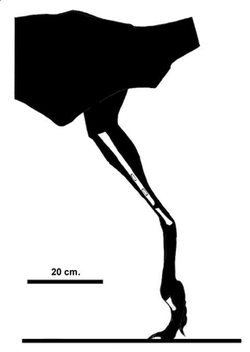
This is a list of dinosaurs whose remains have been recovered from Australia or Antarctica.

This is a list of dinosaurs whose remains have been recovered from Australia or Antarctica.
| Name | Year | Formation | Location | Notes | Images |
|---|---|---|---|---|---|
| Antarctopelta | 2006 | Snow Hill Island Formation (Late Cretaceous, Maastrichtian) | Antarctica | Possessed unusual caudal vertebrae that may have supported a "macuahuitl" as in Stegouros [1] |  |
| Atlascopcosaurus | 1989 | Eumeralla Formation (Early Cretaceous, Aptian to Albian) | Only known from remains of jaws and teeth |  | |
| Australotitan | 2021 | Winton Formation (Late Cretaceous, Cenomanian to Turonian) | The largest dinosaur known from Australia, comparable in size to large South American dinosaurs. Potentially a synonym of the contemporary Diamantinasaurus [2] |  | |
| Australovenator | 2009 | Winton Formation (Late Cretaceous, Cenomanian) | Analysis of its arms suggests it was well-adapted to grasping [3] |  | |
| Austrosaurus | 1933 | Allaru Formation (Early Cretaceous, Albian) | Its holotype was found associated with marine shells |  | |
| Cryolophosaurus | 1994 | Hanson Formation (Early Jurassic, Pliensbachian) | Antarctica ( | Had a distinctive "pompadour" crest that spanned the head from side to side |  |
| Diamantinasaurus | 2009 | Winton Formation (Late Cretaceous, Cenomanian) | May have been closely related to South American titanosaurs, suggesting they dispersed to Australia via Antarctica [4] |  | |
| Diluvicursor | 2018 | Eumeralla Formation (Early Cretaceous, Albian) | Lived in a prehistoric floodplain close to a high energy river |  | |
| Fostoria | 2019 | Griman Creek Formation (Late Cretaceous, Cenomanian) | Four individuals have been found in association |  | |
| Fulgurotherium | 1932 | Griman Creek Formation (Late Cretaceous, Cenomanian) | Fragmentary, but may have been an elasmarian [5] |  | |
| Galleonosaurus | 2019 | Wonthaggi Formation (Early Cretaceous, Barremian) | Its upper jaw bone resembles a galleon when turned upside down |  | |
| Glacialisaurus | 2007 | Hanson Formation (Early Jurassic, Pliensbachian) | Antarctica ( | Basal yet survived late enough to coexist with true sauropods [6] |  |
| Imperobator | 2019 | Snow Hill Island Formation (Late Cretaceous, Maastrichtian) | Antarctica | Initially described as a basal paravian although it may potentially be an unenlagiine [7] |  |
| Kakuru | 1980 | Bulldog Shale (Early Cretaceous, Aptian) | Poorly known |  | |
| Kunbarrasaurus | 2015 | Allaru Formation, Toolebuc Formation (Early Cretaceous, Albian) | Preserves stomach contents containing ferns, fruit and seeds [8] |  | |
| Leaellynasaura | 1989 | Eumeralla Formation (Early Cretaceous, Aptian to Albian) | One referred specimen has an extremely long tail. If it does belong to this genus, it would be three times as long as the rest of the body |  | |
| Minmi | 1980 | Bungil Formation (Early Cretaceous, Aptian) | Had long legs for an ankylosaur, possibly to help it run into bushes for protection [9] |  | |
| Morrosaurus | 2016 | Snow Hill Island Formation (Late Cretaceous, Maastrichtian) | Antarctica | Closely related to Australian and South American ornithopods [5] |  |
| Muttaburrasaurus | 1981 | Allaru Formation?, Mackunda Formation (Early Cretaceous, Albian) | Possessed a short oval bump on its snout |  | |
| Ozraptor | 1998 | Colalura Sandstone (Middle Jurassic, Bajocian) | Potentially the oldest known abelisauroid [10] |  | |
| Qantassaurus | 1999 | Wonthaggi Formation (Early Cretaceous, Barremian) | Distinguished from other contemporary ornithopods by its relatively short dentary |  | |
| Rapator | 1932 | Griman Creek Formation (Late Cretaceous, Cenomanian) | Known from only a metacarpal |  | |
| Rhoetosaurus | 1926 | Walloon Coal Measures (Late Jurassic, Oxfordian) | Retains four claws on its hind feet, a basal trait |  | |
| Savannasaurus | 2016 | Winton Formation (Late Cretaceous, Cenomanian to Turonian) | May have spent more time near water than other sauropods [11] |  | |
| Serendipaceratops | 2003 | Wonthaggi Formation (Early Cretaceous, Aptian) | Possessed a robust ulna similar to that of ceratopsians and ankylosaurs, but was likely a member of the latter group [12] | ||
| Timimus | 1993 | Eumeralla Formation (Early Cretaceous, Albian) | Potentially a tyrannosauroid. [13] If so, it would be one of the few Gondwanan members of that group |  | |
| Trinisaura | 2013 | Snow Hill Island Formation (Late Cretaceous, Campanian) | Antarctica | The first ornithopod named from Antarctica |  |
| Weewarrasaurus | 2018 | Griman Creek Formation (Late Cretaceous, Cenomanian) | Unusually, its fossils were preserved in opal |  | |
| Wintonotitan | 2009 | Winton Formation (Late Cretaceous, Cenomanian) | More gracile than other contemporary titanosaurs |  |
This is a timeline of selected dinosaurs from the list above. Time is measured in Ma, megaannum, along the x-axis.
